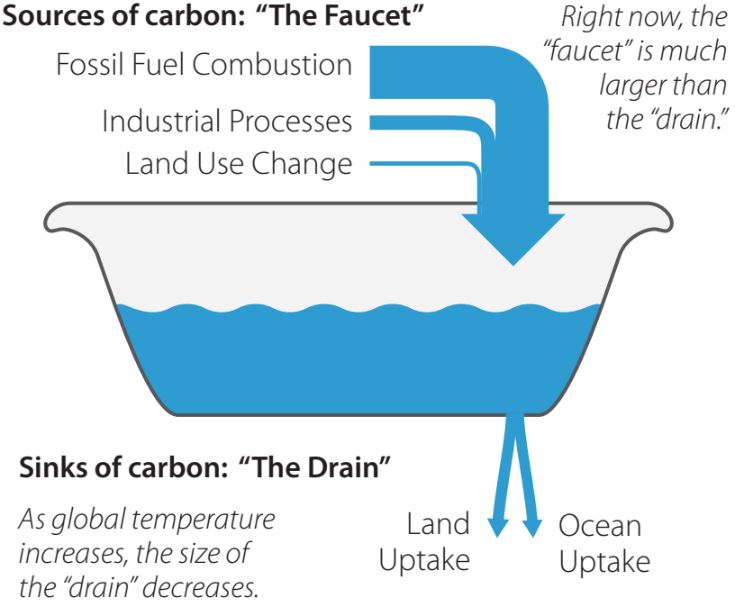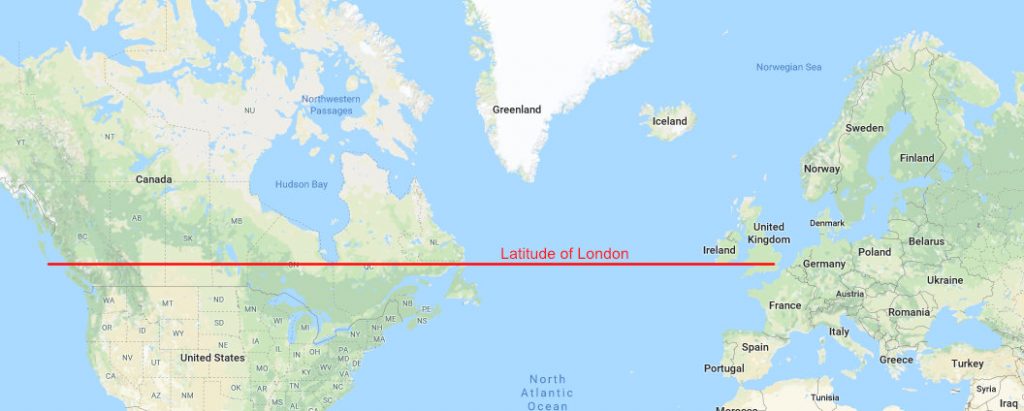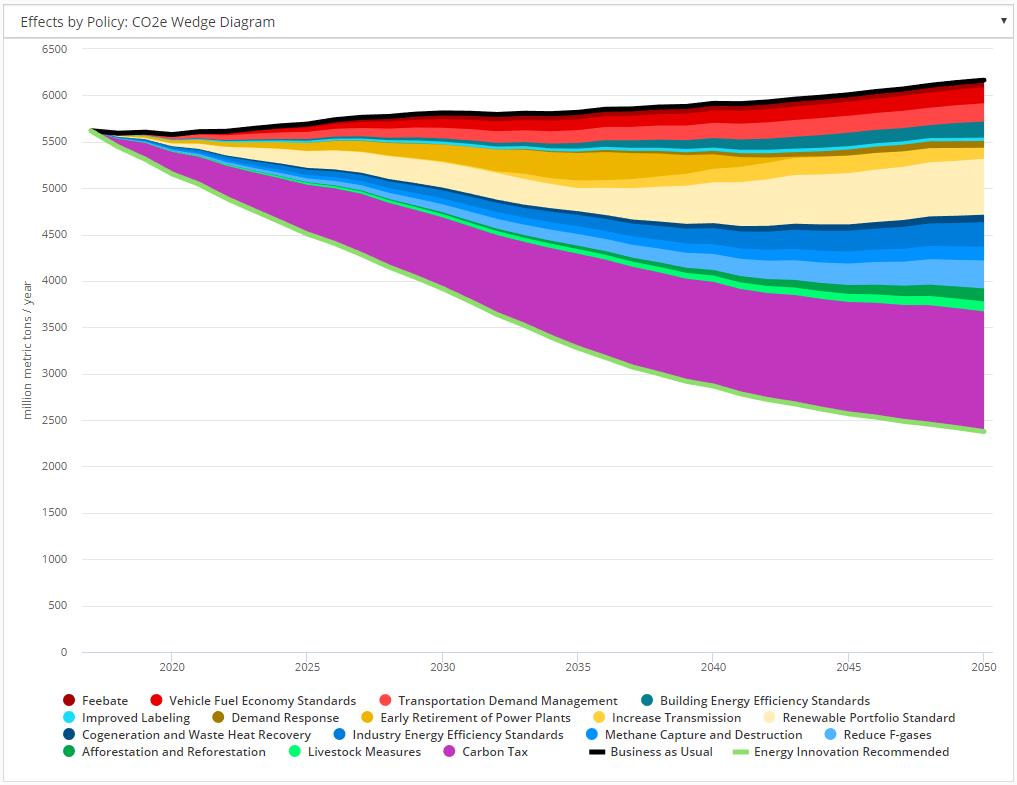There is no way to seriously study climate change without having a very sobering moment. It is extremely difficult to land this planet at a reasonable climate future, but it is not impossible, and solutions exist to meet the challenge. The parallel truths are that the stakes are higher—far higher—than most realize, and that delay makes solutions impossible.
Climate change is a problem of stocks, not flows. Like a bathtub, where water levels continue rising as long as more water flows in than drains out, even a dramatic reduction in CO2 emissions will not reduce concentrations as long as emissions outpace removals.

A word on the stakes, before jumping into solutions. Both natural and human systems can go non-linear—that is, early changes can unleash massive further change. Some scary and then encouraging examples:
- As ice melts, it lubricates the next ice sheet collapse and it darkens the ocean and land, increasing its ability to absorb sunshine.
- Defrosting tundra releases massive amounts of CO2 and methane, a super-powerful greenhouse gas. Molecule for molecule, methane traps 28 times more heat than CO2 over the century after it is emitted. Its impact is indescribable and irreversible.
Our habitat and agriculture rely on massive conveyor belts of water currents that mitigate temperature extremes. One of these planetary heat-movers, the North Atlantic Current, is the reason most of Europe is habitable, even at its northern latitudes. For proof, look at a globe, and see just how far north temperate parts of England and the Scandinavian countries are, compared to, say, Canada.

These oceanic water flows can stop if they get too much cold water in them—see the ice-melt bullet, above. The last time they stopped, Europe was under a mile of ice—and the North Atlantic Current’s circulation is the weakest it’s been in 1,600 years.
Human systems can go non-linear too:
- The IT revolution, with technology doubling in capacity every couple of years, has wrought amazing changes. Many of the same technologies have been brought to bear on renewable energy:
- Solar panels have dropped in price by almost 90 percent in the last decade, making solar the planet’s cheapest energy source.
- Onshore wind power prices have fallen nearly 70 percent since 2009, and in many markets building new wind is now cheaper than running existing coal or nuclear plants.
- LED lights, batteries, and other technologies are undergoing similar, non-linear transformation.
- Waiting in the wings: Advanced manufacturing, green chemistry, zero-net energy buildings, and more.
So the presiding question is: Can the fast solutions beat out the fast problems? The answer is a matter of choice, not fate. With the right choices, we can still have a reasonable climate future.
But we have no time for false starts, for chimerical solutions, or for ideas and technologies that cannot scale. In other words, well-meaning but slow, or small, or costly solutions are actually counter-productive, as they absorb time, money, and political attention without delivering the goods.
Our team at Energy Innovation has developed the Energy Policy Simulator (EPS), a peer-reviewed tool to test different policy paths, with an eye to objectively understanding their impact on emissions and other metrics of concern to policymakers.
The goal is simple: Divine the best policies, country-by-country, to avoid climate change—and at the same time, reduce conventional pollutants and to save money. The EPS model starts with a business-as-usual projection for each country, based on official government data where available, then empowers users to pick from hundreds of policies and test their combined ability to reduce CO2 emissions, instantly showing the results on emissions, costs, and so on.
The free and open-source model is available on the web, in an easy interface. Anyone can download the model and input data, then review or alter the workings of the model and input data. When you experiment with it, you will have some of your assumptions challenged; we certainly did. But you will also learn, in short order, that an intelligent suite of policies can drive down carbon.
Our first model was built in partnership with two Chinese government think tanks, to learn about the options for the world’s largest carbon emitter. We have since built versions for the United States, Mexico, Poland (Europe’s second-biggest coal consumer), Indonesia, and Canada. We are wrapping up India and California versions now, and we expect to have them online later this year. With the India version, these models will cover more than half the world’s CO2 and span many different country types.
For non-U.S. regions, we have done our work with a strong, credentialed local partner. We have had access to official government data, and have used extensive peer review of the model—by prominent university faculty and researchers at three national labs.
The punchlines:
- No single policy gets the job done. A strong price on carbon, for example, is very important, but does very little to the buildings or transportation sectors, and has diminishing returns as the grid decarbonizes.
- Selecting policies that directly affect the four big energy sectors—electricity, transportation, buildings, and industry—is crucial. Within each realm, a small number of policies make a big difference and a large number are only modestly helpful.
- Implementing strong building codes and fuel economy standards is urgent, because vehicles and buildings last a long time. Even well-designed standards require years to achieve their full benefits, as building stocks and transportation fleets take years to turn over.
- Getting started early makes all the difference. Late starts make it impossible to hit a reasonable climate goal. Waiting for the perfect technology—advanced nuclear power, say, or carbon capture and removal—is a recipe for losing. That said, R&D creates long-term options that are valuable so long as they are not counted on as substitutes for near-term action.
- Because the scarcest resource is political bandwidth, it is crucial to focus on the powerful policies, rather than on sweet-sounding auxiliaries.
Dig in, test out your favorite policies, see how they do. Pick a country from the list, and try to hit your 2030 or 2050 target. There are paths, grounded in reality, that work, but many more are essentially decorative. Test the model’s assumptions, and suggest improvements. But, most important, use this and other information to focus on what matters and what works.
Hal Harvey’s Insights and Updates offers monthly thoughts and analysis on current energy and climate topics. These newsletters are written by Energy Innovation’s CEO Hal Harvey. Sign up here to receive Insights and Updates straight to your inbox.

